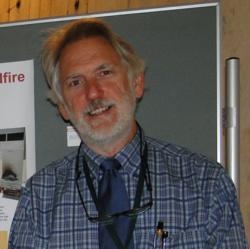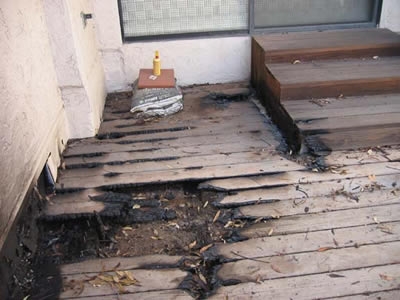
Posts Tagged: Quarles
Steve Quarles takes job with insurance institute

He will also occupy the South Carolina Wind and Hail Underwriting Association Hazard Resilience Chair at the IBHS Research Center.
Quarles has been a wood durability advisor for UC Cooperative Extension since 2000.
“Although my years with UC Cooperative Extension were very rewarding, I could not pass up the opportunity to work for IBHS and in particular at the Research Center with its scientists and staff," Quarles was quoted in the news release. "I am excited to have a more direct role in IBHS research and outreach activities that will help improve the durability of our new and existing buildings.”
Quarles has a bachelor's degree in forestry from Virginia Tech, and master's and doctorate degrees in forest products from the University of Minnesota. He is co-chair of the eXtension Wildfire Information Network (eWIN) Community of Practice, and is a member of the Society of Wood Science and Technology, the Forest Products Society, American Society of Testing and Materials, American Wood Protection Association, the National Fire Protection Association, and the Association of Natural Resource Extension Professionals.
“Steve brings a wealth of experience in the areas of wood durability, aging, water penetration, and wildfire - all critical aspects of our field and laboratory research programs," the release quoted Julie Rochman, IBHS president and CEO. “We have long admired Steve's meticulous, incredibly smart work, and look forward to having him add new dimensions to our already impressive group of property loss mitigation experts.”
Quarles begins his new position Aug. 1.
Protecting a home from wildfire for $20 or less
There are many things homeowners can do to protect their homes from wildfire that cost $20 or less, said the Insurance Institute for Business and Home Safety in a news release distributed yesterday.
The article suggests undertaking low-cost, simple but important safety steps like clearing gutters, sealing around doors and covering vents.
Last month, the organization conducted the first-ever full-scale wildfire demonstration at its South Carolina research center. The demonstration was part of a building science initiative designed to illustrate how easily some commonly used materials and items near or on houses can ignite from embers, and what homeowners can do to better protect their homes.
“Most people believe that it is the advancing line of flames during a wildfire that destroys homes,” IBHS president was quoted in the story. “Rather, it is embers or firebrands that create spot fires by igniting vegetation, debris and flammable materials that lead to ignition of the exterior of a house, as well as embers blown or drawn into buildings through gable vents, soffit vents and other openings that can ignite a house from the inside. And our laboratory test vividly demonstrated just that.”
The article credited UC Cooperative Extension for contributing to its list of suggestions for improving a home's chances of survival when a wildfire threatens. The suggestions include:
- Ensure the home has a Class A rated roof.
- Maintain a carefully managed and maintained vegetation zone within a five-foot zone adjacent to the home.
- When a wildfire is threatening, close the windows.
- Clean debris out of rain gutters.
- Install end-stops (bird-stops) at the edge of the roof if there are gaps.
- Do not store combustible items, such as firewood and lumber, under the deck.
- Keep all gaps clear of vegetative debris or cover gaps with metal siding.
- Make sure the garage door is well sealed at the edges.
UC Cooperative Extension wood durability advisor Stephen Quarles has developed an online Homeowner's Wildfire Mitigation Guide with detailed instructions for making changes to a home and its surroundings to reduce the possibility of damage from wildfires.

This deck had debris in the board gaps that caught fire.
Chron helps distribute UC fire information
The Sweat Equity column in the San Francisco Chronicle today steered readers to a UC PowerPoint presentation on the Web that provides details on fire-resistance ratings for roofs.
Produced by UC Cooperative Extension wood durability advisor Steven Quarles, the 18-slide presentation gives viewers an understanding of how roof coverings get their fire rating.
The information in Sweat Equity, a regular home improvement column written by brothers Bill and Kevin Burnett, was prompted by a reader question about whether an existing shake roof can be treated for improved fire resistance. In short, the answer is no.
Roofing systems are fire-rated either A, B, C or not ratable, with A the highest rating, or most fire resistant, according to the article.
If homeowners wish to preserve the woodsy and casual appearance of a wood shake roof, the Burnetts said the existing shakes should be replaced with new fire-retardant pressure-treated wood shakes. Alone, the pressure-treated shakes result in a class-B roof covering; in conjunction with an underlying fire barrier material, such as this gypsum or fiberglass, the roof is class A.
For more information on improving homes' fire resistance, see Quarles' Homeowners Wildfire Mitigation Guide online.

When new, an asphalt composition roof has a class A rating.
UC expertise shared by national news outlets
Two nationally recognized news outlets featured UC experts in recent stories - National Public Radio and the MSN Web site.
Agricultural Issues Center director Dan Sumner provided comment on the NPR story about a trend at Walmart stores to stock "locally grown" food. The story pointed out that the megastore's definition of locally grown -- grown within the state's boundaries -- is different from that of many locavores -- which generally define local as within 100 miles of home.
On the radio program, Sumner said the company's strategy could spell problems for California if it catches on nationwide.
"If people decide they're going to consume locally, that means they're probably not consuming our walnuts and apricots and almonds and everything else we grow around here," Sumner said.

The MSN Web site's real estate reporter Christopher Solomon wrote a story about home building tips in wildland fire zones. He spoke to UC Cooperative Extension wood durability advisor Stephen Quarles.
Quarles' comments centered mainly on roofing materials.
"One of the things that I frequently hear is that you need a metal roof. That is not true," Quarles was quoted.
Quarles' information and comments were also used to create a bulleted list about non-combustible roofing materials.